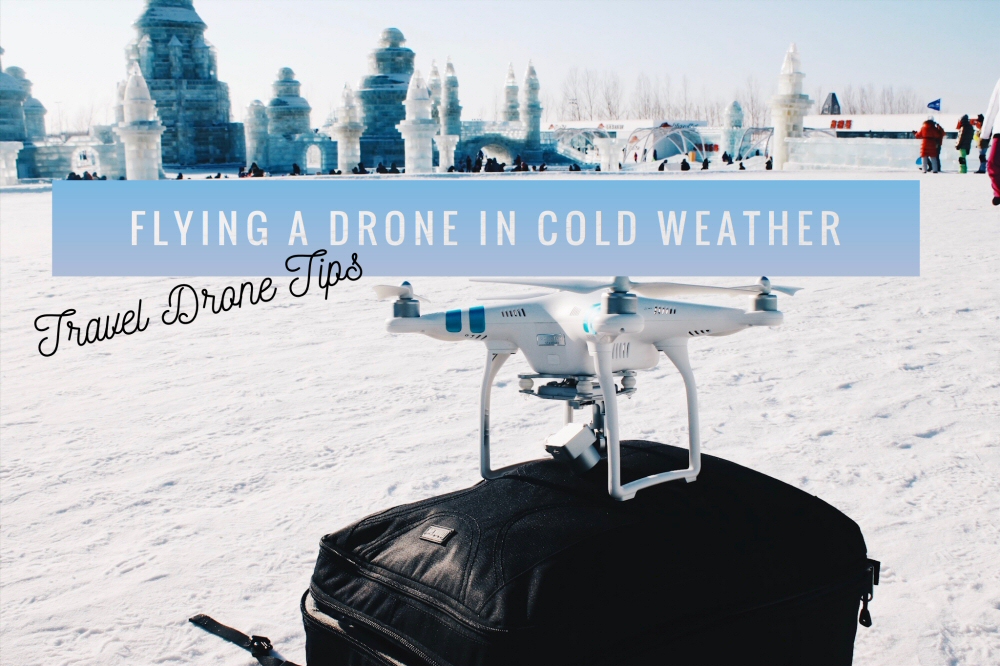
The snow-dusted landscapes of winter will certainly inspire you to capture the chilly season’s magnificence from the sky. And with so many winter travel destinations to choose from, why not? So let’s learn how to do it! The following guide will detail the travel drone tips you NEED to know when flying a drone in cold weather.
We’ve already gone into detail about traveling with a drone, and the best travel drone bag to accomplish such a task. But flying a drone in cold weather to capture these winter wonderlands introduces a whole new set of issues and concerns you’ll have to attend to before packing up your DJI Mavic, GoPro Karma, or whatever else you’re flying for the winter road.
Flying a drone in cold weather brings:
- denser air
- reduced battery efficiency
- increased potential for battery shutdowns
Flying a drone in cold weather also brings a whole additional set of procedures to follow and accessories to pack, which we will go over in the following post.
After traveling with a drone ourselves to the coldest city in China for the Harbin Ice Festival, the world’s largest ice sculpture festival (and flying in a whopping -2 °F), we’ve compiled our own essential travel drone tips for flying a drone in cold weather.
Here’s everything you need to know about flying a drone in cold weather!
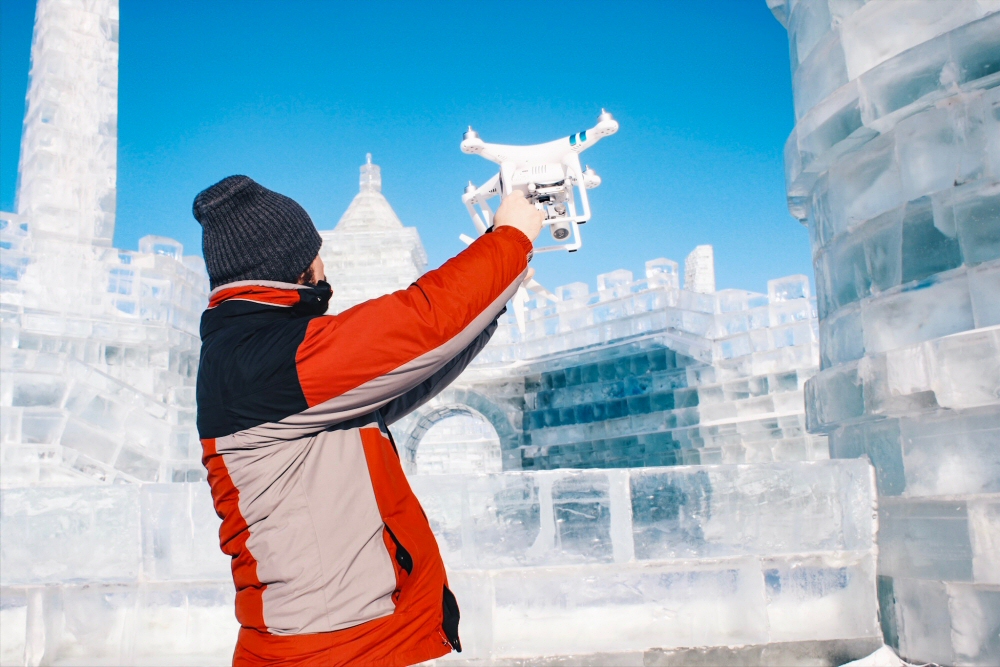
Contents
- Battery Life is Diminished
- What You Need to Pack When Flying a Drone in Cold Weather
- You’ll Need to Follow Additional Travel Drone Procedures
- Avoid Flying in the Snow
- Always Keep Your Eye on the Battery Voltage
- When in Doubt, Check Your Manual
- Flying a Drone in Cold Weather: Final Thoughts
- Like this post?
- You Might Also Appreciate…
- Do you have any other tips for flying a drone in a cold weather?
Battery Life is Diminished
One of the most essential travel drone tips I can give you when flying a drone in cold weather is to pay close attention to your battery life, as cold temperatures will shorten flight times.
Our DJI Phantom, for example, will go from a typical 20-25 minutes to anywhere between 10-15 minutes when flying in cold temperatures.
The subzero temperatures at Harbin’s Ice and Snow World limited our flying time, but we still had long enough to capture this magnificent aerial view!
And what’s the culprit for shortened flight times?
Most drones use lithium-polymer (LiPo) batteries, and LiPo batteries drain like nobody’s business in cold temperatures. Chemical reactions are slowed, blah blah blah—it’s science, and it can start at 15°C (59°F).
How Do You Keep Your Batteries Working?
To keep your LiPo batteries working in cold temperatures, you’ll want to try to warm up your batteries as much as possible.
And some stellar travel drone tips for keeping your batteries warm?
Travel Drone Tips for Keeping Batteries Warm
Use hand warmers and wrap your drone batteries in scarves around your LiPo Safe Bags to keep them ready for use.
And if you don’t have a hand warmer hot and ready for you, pop a wrapped drone battery in your armpit until it’s warm enough to fly with.
Remember, a DJI Phantom will not start its motors unless the battery is 15°C. For extra caution, try to warm your batteries to 25°C before attempting to fly.

Don’t Put Your Drone on the Cold Ground
Additionally, avoid putting your quadcopter directly on the cold ground, as we’ve noticed this drops the drone’s temperature, bringing the drone batteries’ temperature down with it.
For us, this means we only launch off of our Think Tank Airport Helipak drone bag or by hand. For a thorough review of the bag, make sure to check our our guide to the Best Travel Drone Bag!
This works for us, but exercise caution and perform any hand-launching or -catching at your own risk. We do not endorse hand-launching or hand-catching and we will not be held accountable for any accidents resulting from these activities!
| Don’t forget the important items for winter travel! Check out this essential winter travel packing list! |
Remember to Keep Your Other Batteries Warm
Now remember, drone batteries are not the only batteries you’ll be using, nor are they the only ones affected by the cold temperatures.
Your phone or tablet will also experience a reduced quality in battery life, and the proper measures should be taken to ensure your device doesn’t shutdown in the middle of a flight.
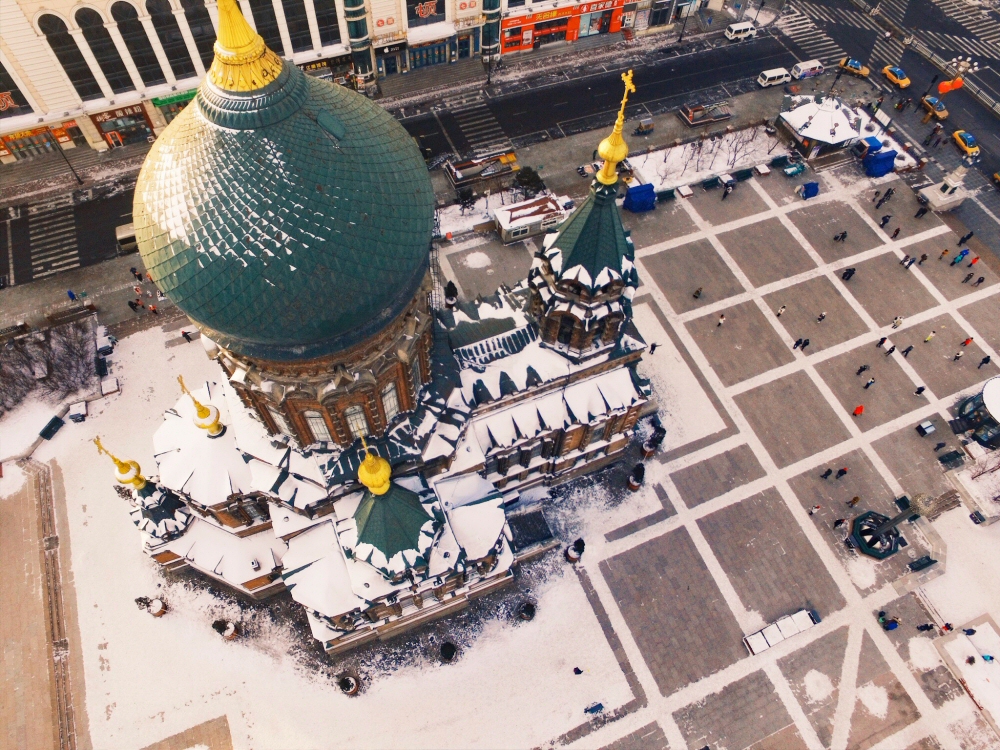
We Learned This The Hard Way: Our Phone Battery Died Mid-Flight
While flying a drone in cold temperatures at the St. Sophia Church in Harbin, China, this is exactly what happened to us. Our phone shutdown in the middle of a flight, and though I was able to fly the drone just fine using the remote controller, I wasn’t able to take any photographs or video, forcing me to land.
Once the phone shut off, it wouldn’t start up again until I got it plugged into a power outlet.
Avoid this annoyance by following these travel drone tips and keeping an attachable hand warmer strapped to the back of your phone.
It’s an easy fix, and it will keep your phone or tablet functioning properly.

What You Need to Pack When Flying a Drone in Cold Weather
Here are some travel drone tips for you: bring stuff, and for cold weather, bring more stuff.
Just as you’d need to pack several things to protect your body in cold weather, you’ll also need to bring some extra gear to protect your drone.
Though we’ve already mentioned some of the extra items you’ll need to pack when flying a drone in cold weather, we’ll go ahead and make a nice little list so you don’t forget any essentials.
Packing List for Flying a Drone in Cold Weather
- Hand warmers. These babies should be kept around the batteries and even strapped onto your phone/tablet to keep them as warm as possible.
- Warm scarves or beanies. When storing your batteries, keep them wrapped in warm scarves and beanies (along with the hand warmers). Keeping a scarf-wrapped battery in your pocket is even better!
- Touch-screen gloves. Protect your hands from the cold while operating your drone. Make sure they have grip on them so you have a firm hold on the RC and phone/tablet. The more skin-tight the better! Loose-fitting gloves will make handling the RC and app significantly more difficult.
- Back-up portable charger for phone/tablet. Even more necessary in very cold temperatures! Bring more than one if you can!
- A protective drone bag with rain cover. This is always a necessity, but even more essential when trekking through extreme winter temperatures and snow.
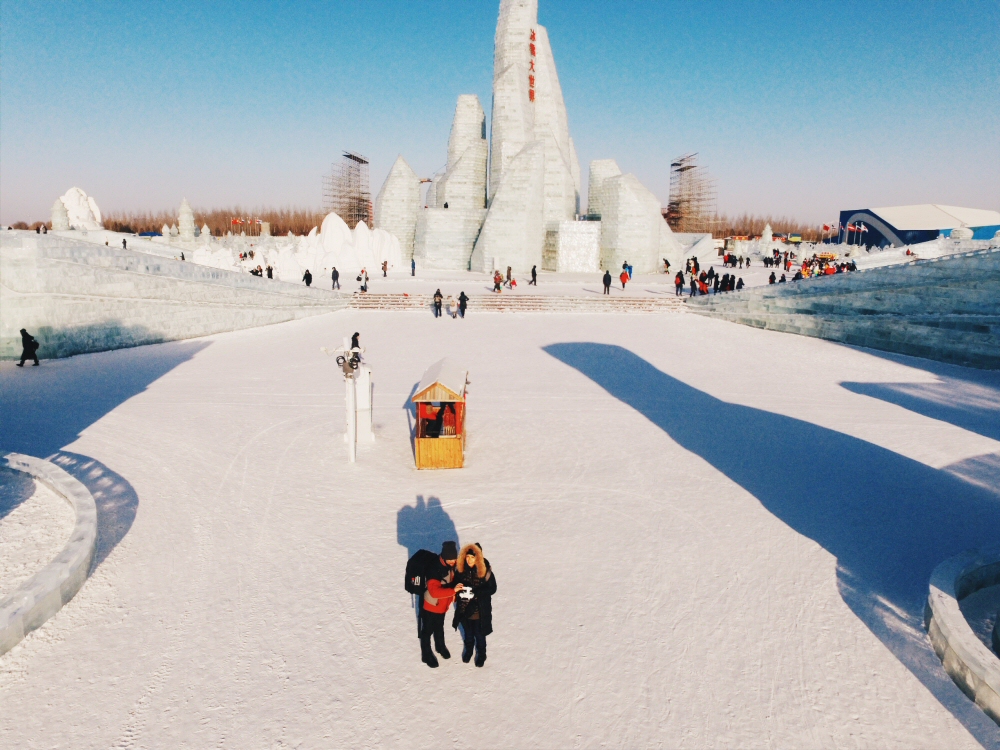
You’ll Need to Follow Additional Travel Drone Procedures
In addition to those extra accessories you’ll want to pack, be extra careful when launching, flying, and landing in cold temperatures.
| Follow these travel drone tips for flying a drone in cold weather: |
And if it’s snowing? You probably shouldn’t fly. |
Avoid Flying in the Snow
A DJI Phantom simply isn’t waterproof, as well as most other drones (no, not even the DJI Mavic).
And yes, it may be beautiful and dainty, but snow is still precipitation, and it can certainly do some damage to your drone, remote controller, motor, camera, or gimbal.
When flying your drone in cold weather, watch out for rain or snow, and land immediately if you get any.
Dry off your drone and props well before they have a chance to freeze, especially paying close attention to your camera and gimbal.
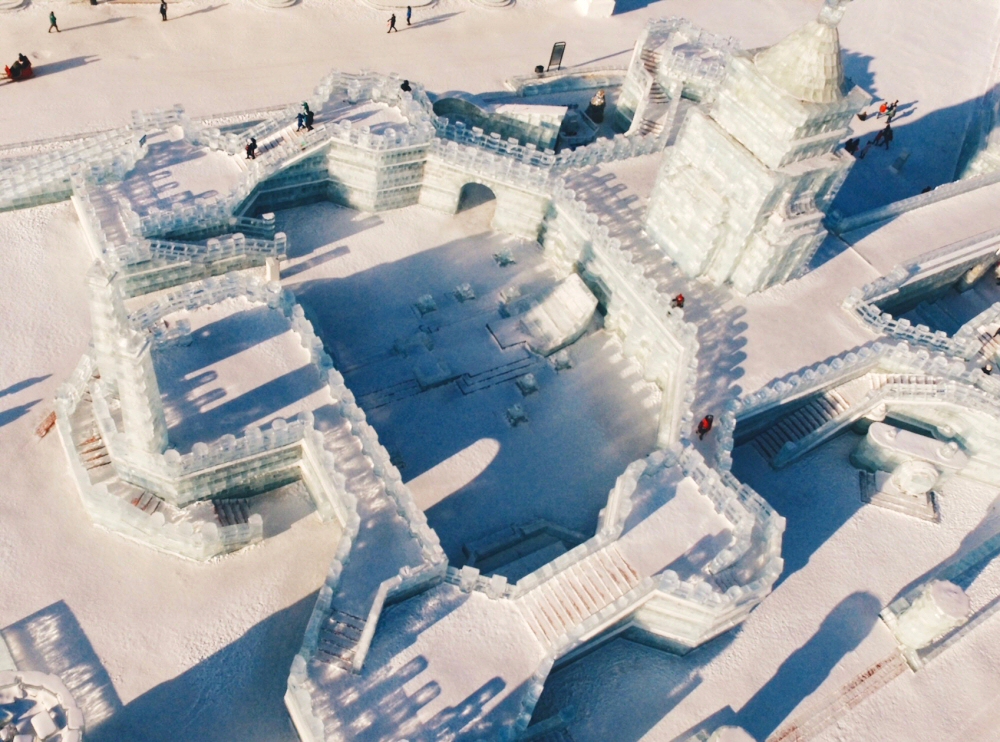
Always Keep Your Eye on the Battery Voltage
Of all the travel drone tips for flying a drone in cold weather, I’ll go ahead and reiterate this again.
In cold temperatures, a drone is working overtime in the dense air with reduced battery life, so make sure to keep a close eye on your battery’s performance whie in the air.
For extra caution when flying a DJI Phantom, turn on the “Show Voltage on Main Screen” on the Aircraft Battery page of your DJI Go app, and land immediately if the battery voltage goes anywhere below 3.2v.

When in Doubt, Check Your Manual
Even with all our travel drone tips for flying a drone in cold weather, you should always consult your manual as the final word for safely operating your quadcopter.
Since most drones are built to fly anywhere between 32°F – 104°F (0°C – 40°C), you’ll likely be able to fly even in sub-optimal weather conditions.
Still, your drone’s user manual will have every instruction you need to ensure the ultimate safety of your drone, as well as that of your battery and gimbal.
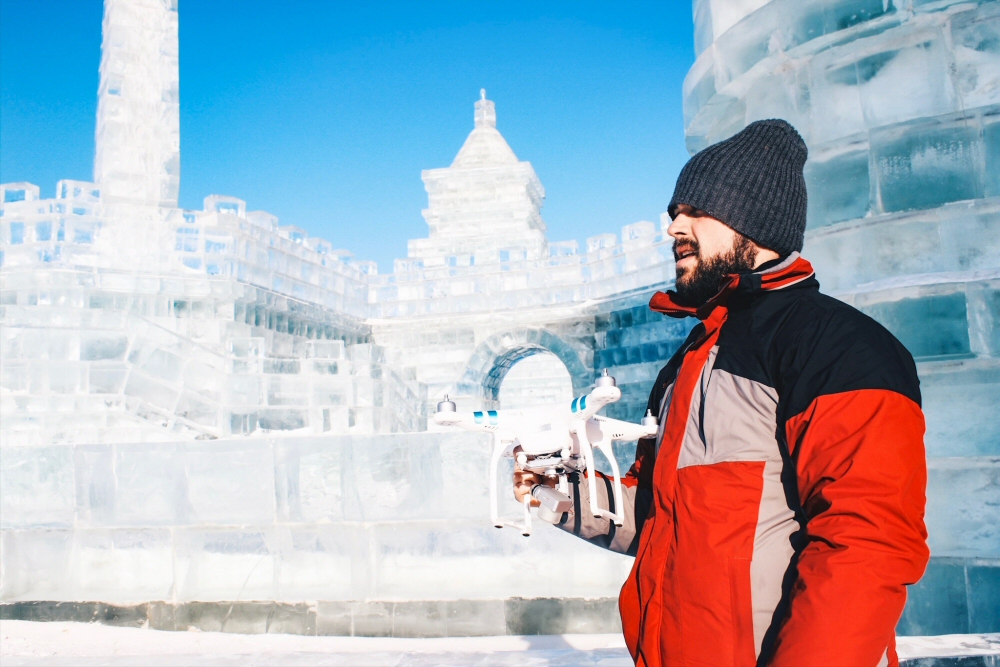
Flying a Drone in Cold Weather: Final Thoughts
Though flying a drone in cold weather brings its own additional set of procedures and required materials to do safely, it’s often worth it for those magical winter wonderland shots.
Even with reduced flight times and increased risk of flying in cold temperatures, a healthy dose of preparation and caution can help you ensure a safe flight to the best of your ability.
By following these travel drone tips for cold weather flights, you’ll be able to limit the cold weather’s negative effects on the drone as much as possible, and do everything in your power to work towards smooth sailing.
Like this post?
Share it on Pinterest by hovering over the picture below and clicking the red “Pin It” button!
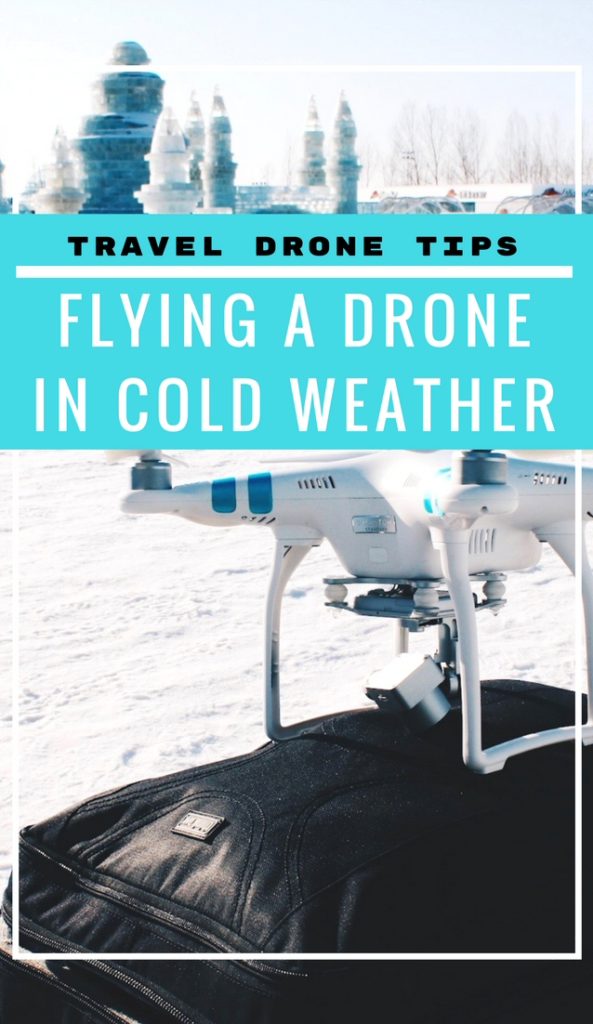
You Might Also Appreciate…
More Winter Posts
- Top Winter Destinations, According to Travel Bloggers
- Essential Winter Travel Packing List (For Subfreezing Temperatures!)
- The Jeju Island Winter That Shut Down the “Hawaii of Korea”
- A Russian Church in China?! || A Guide to Saint Sophia Cathedral in Harbin, China
- This China Ice City Will Blow Your Mind: The ULTIMATE Guide to Harbin Ice Festival
More Drone and Gear Posts
- Traveling with a Drone: 8 ESSENTIAL Tips to Avoid Insanity
- Best Travel Drone Bag: Backpacking with a DJI Phantom
- Essential Cameras for Every Traveler
More Photography Posts
- 15 Machu Picchu Pictures to Remind You How Badass It Is
- 30 Photos That Prove the South Korea Autumn Just Won at Life
More Travel Posts
- Travel Hack: Do a Cheap Flight Search Like a Pro
- What I’ve Learned from Traveling to 25 Countries
- A Guide to Sapa Trekking and Hill-Tribe Homestay (Without Sapa Tours)
- Hidden Beach of Jeju Island: A Jeju Korea Travel Guide
- Instagram-Worthy Reasons to Visit Italy
Do you have any other tips for flying a drone in a cold weather?
Share it in a comment below!
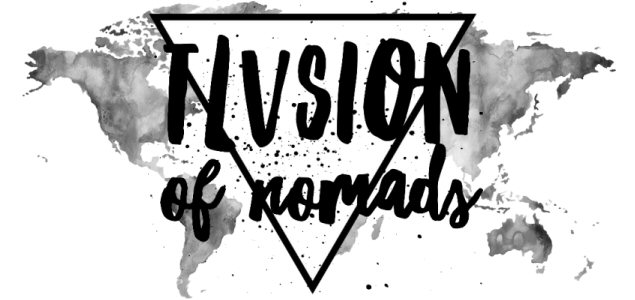

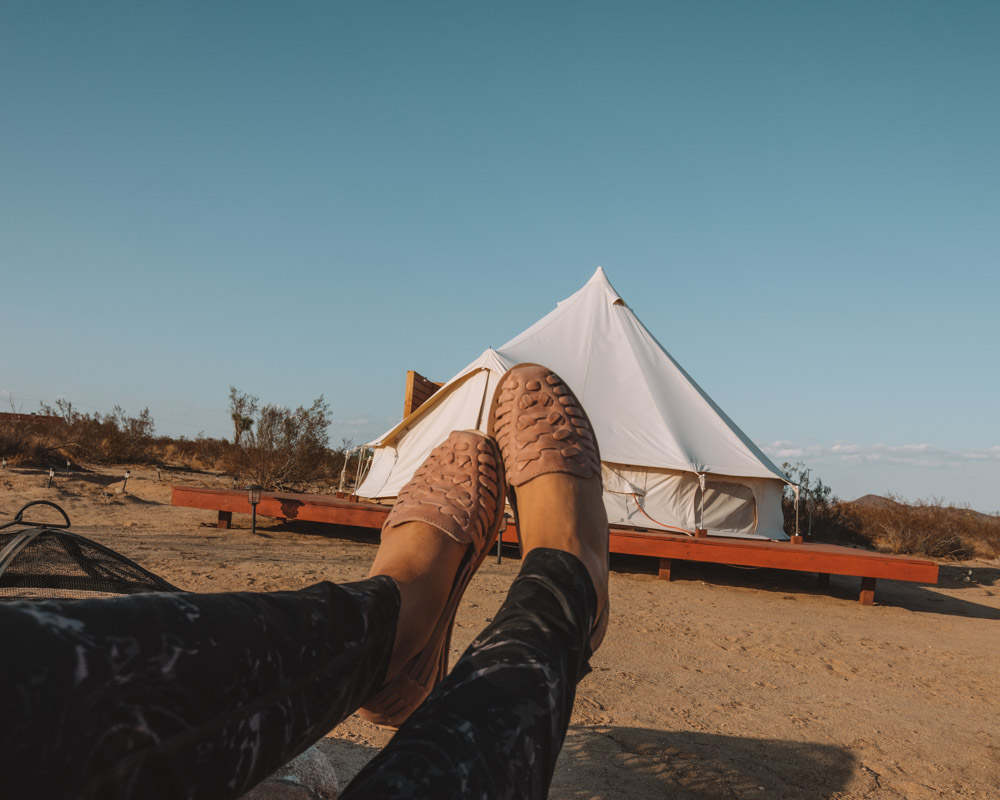

9 Comments
Maartje
at 10:32 pmGreat tips Lauren & your photos are so beautiful, thanks! I wish I bought a drone to Mongolia in October. Will definitely use your tips when I finally buy one 🙂
Silvia
at 2:41 amI live in Norway and recently got a drone so this post was SO helpful. Thanks for all these tips!
Television of Nomads
at 9:16 am[…] Travel Drone Tips: Flying a Drone in Cold Weather […]
Television of Nomads
at 7:36 pm[…] Having brought our drone to the coldest city in China for Harbin’s Ice and Snow World (the largest ice festival in the world), we’ve learned every essential you need to know for traveling with a drone in cold weather. You’ll need to account for shorter flight times, decreased battery life, problematic voltage, and so on, and their are several essential accessories you MUST bring when traveling with a drone in the winter (such as hand warmers, scarves or beanies, touch-screen gloves, and a portable charger for phone/tablet). For every important detail of what to bring and what procedures to follow for cold weather drone travel, check out our Travel Drone Tips: Flying a Drone in Cold Weather. […]
Television of Nomads
at 11:56 am[…] cold weather drone travel, we also have travel drone tips for flying in cold weather, which is a whole ‘nother set of […]
Television of Nomads
at 9:53 am[…] Best Travel Drone Bag: Backpacking with a Dji Phantom […]
Television of Nomads
at 12:20 pm[…] using touch-screen electronics or flying a drone in cold weather, make sure to get yourself a pair of skin-tight touch-screen […]
Kate
at 7:48 pmSo useful information, thank you!
But I have a question. Is it allowed to fly drone above ice and snow festival? Because I’ve been in many cities of China and everywhere guardians told it’s prohibited, once even police.🤦🏼♀️ How to know is it prohibited or not?
Lauren West
at 9:59 amThank you, I hope it can help! As for flying above the Harbin Ice Festival–we didn’t have any problems ourselves and we actually saw one other Chinese person doing it. There were no guards around when we flew, or we would’ve asked. We did fly elsewhere in the city of Harbin (here: https://televisionofnomads.com/saint-sophia-cathedral-in-harbin-china/), and asked the police, as there was some kind of police station nearby. They didn’t speak English, but we took the drone out and pointed to it and mimed that we wanted to fly it, and they nodded their heads in approval, giving us the okay to fly.